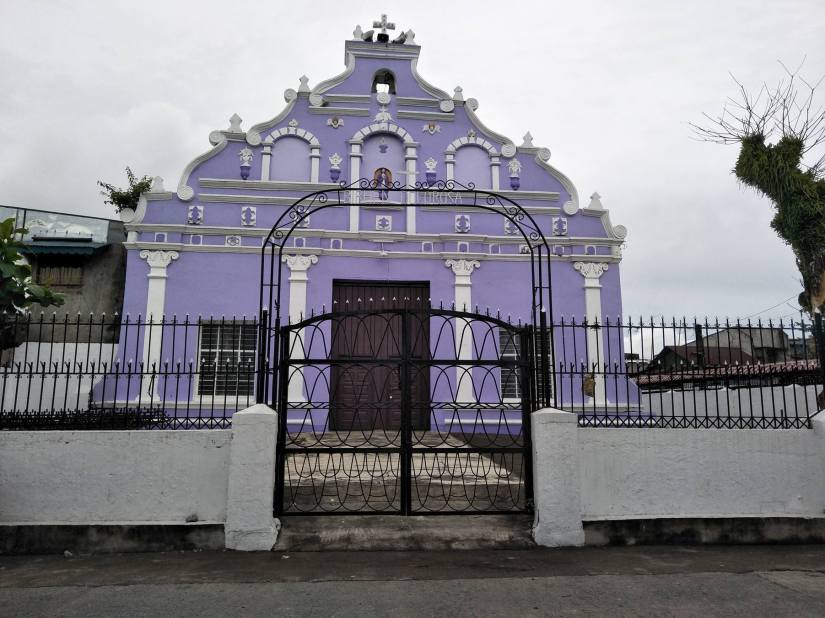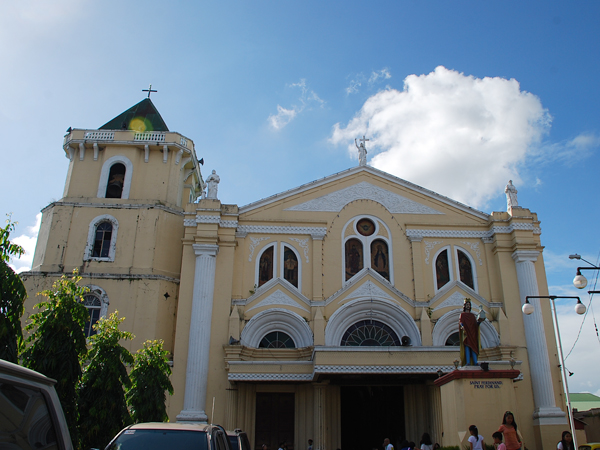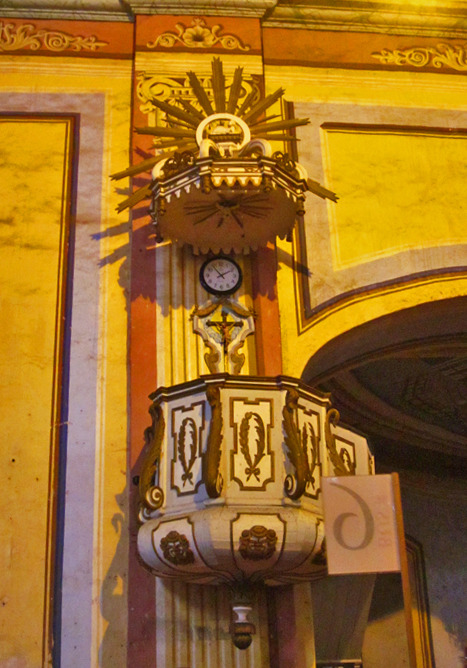Dora and Boots traveled the forest to find some uncommonly used Filipino words. Join them as they discover the words and its meanings.
Watch our video and enjoy!
Discover the life of Dora and her friend Boots as they find uncommonly used FIlipino words.
Dora and Boots traveled the forest to find some uncommonly used Filipino words. Join them as they discover the words and its meanings.
Watch our video and enjoy!
During the Post World War II period. Ibabang dupay was selected as the site of the Red V coconut Product Ltd. Fr. Florante Dator was appointed first parish priest in 1958. Housed temporarily in the second floor of the residence of Maria Jaca, he said mass at the rest house of the coconut company, which lured workers from other places. In 1950, the earliest masses for Sunday and patronal feast were held at the apartment unit offered by Timoteo Jaca. Soon Novenas in honor of the mother of Perpetual Help and other devotions begun to take place there regularly, then seminarians organized catechetical classes, and in 1955, religious organizations such as Apostolado ng Panalangin and the Legion of Mary were formed. The curate of St. Ferdinand Parish, Msgr. Diego Conti was said to have recommended the elevation of Ibabang Dupay to a parish.

To accommodate the increasing number of mass attendees, Sofronio Dialola allowed the use of his vacant lot in front of Fr. Dator’s temporary living quarters. The church was permanently build on the lot donated by Severo Marquez. In the term of Fr. Herminio Lagustan, the church and convent were expanded. A couple of Redemptorist priest did missionary work and the local government donated a pre-fabricated building to be used as a social hall and day care center.

Fr. Pio Manalo introduced the Block Rosary, rebuild the convent, fenced the church property and said mass in almost all of barangays. Fr. Manuel Lim was curate from November 1982 to February 1983. Msgr. Oscar Leaño implemented an intensive cathechetical instructions drive and divided the parish into kawans. Where the dalaw misa was help in May. He oversaw the silver jubilee celebration of the erection of the parish and renovated the convent. Msgr. Atilano Oracion renovated the side of the church. The new tabernacle was blessed during the term of sgr. Armando Perez. He was succeeded by Msgr. Luis Balquiedra, Fr. Zaldy Maaño and Fr. Joseph Estremera.
We have here a video featuring the St. Isidore the Farmer Parish and other churches in Tayabas and Lucena. Enjoy watching 🙂

There are two Mortuary Chapels in Tayabas town and one here is Sanctuario de las Almas or Chapel of the Souls.
In 1755, the Spaniards built the Campo Santo Para Los Españoles. It is a grave for only pure Español but there are also burials here Filipino elitist.
Campo Santo Para Los Españoles
This church is built facing the Tayabas Bay in the South so that the people from the Spanish Era can see from the bell tower of the Minor Basilica of St. Michael the Archangel if there are upcoming Moro Pirates or marine merchants .The Sanctuario de las Almas is unique because it directly faces the Minor Basilica of St. Michael the Archangel. People also believe that there is an underground tunnel connecting these two churches that the Spaniards used the revolutionary period to go to different locations without the knowledge of Filipinos.
A picture via Google Satellite showing the position of the two churches
A representation of the underground tunnel of the church
In 1845 the camp of saint was enclosed by a thick stone pillar. The construction of the Sanctuario de las Almas was also commenced in 1855. It is one of the largest mortuary chapels in the Philippines despite the lack of funding since its lack of funding.
Stone Pillars that fences the chapel
Today it is a sanctuary for the devotees of San Diego de Alcala.
San Diego de Alcala Image in the wall of the church

Hermita Nuestra Señora de Angustias is one of the oldest church in Tayabas. The chapel was built in 1838. Its roof was renovated in 1845. In 1887, the chapel was described as having a small cloister, a modest presbytery and a sacristy to the right side of the presbytery. The walls had four windows of capiz and glass. People said that the Minor Basilica of St. Miguel Archangel should be built in the position of this church but because the soil can’t handle it, the Basilica was moved blocks away from it.
Ermita Church 1887
Perhaps you wonder why the churches in Tayabas are near to each other. According to legend, the image of the Virgin Mary has long been placed in the grand church but it has always been missing and found in the church today. This is why the church built this image for the exact place where it was found.
Virgin Mary Image
It is now known as Ermita Church. It is also a center of the Turumba Festival of Tayabas where every Biernes de Dolores is held and a procession offering dance in thanks to the Virgin Mary.
Turumba de Tayabas last April 16,2015
St. Ferdinand Parish was founded by Fr. Mariano Granja, the first Parish priest of Lucena, way back March 1, 1881 then the construction of the church itself started in 1882 and was finished by 1884.It was Monsignor Alfredo Verzosa, then Bishop of Lipa, who paved way for having a diocese here in Lucena when he built a minor seminary in 1942. This seminary became the foundation of building the Diocese of Lucena. On March 28, 1950, Pope Pius XII issued a bull Quo Aeternae Dominici Gregis establishing the Diocese of Lucena and was expedited on May 20, 1950. And finally on September 8, 1950, the Diocese of Lucena was canonically erected.

The St. Ferdinand cathedral is located at the heart of Lucena City’s Poblacion (town proper) it is a common stop and meet- up place for everybody in the town. Some will just pass through the church and some religious persons will allot a little amount of time to go inside the church to visit and pray.
Why it was name as “St. Ferdinand Cathedral”?
First thing is that, the patron saint of these church is St. Ferdinand. Also, the construction of these church was dedicated to St Ferdinand. Second, it is called “Cathedral” because of it’s very significant feature. The “cathedra”. Cathedra is a latin word meaning “chair”. The cathedra is the chair, or we can say the throne of the elected bishop of one diocese. And as the cathedra of Most. Rev. Emilio Z. Marquez DD. is located at St Ferdinand it is right to call the church as a cathedral.

According to some staffs in that place, when tourists are visiting the church they always says that the ceiling of the church was so amazing, they feel like they are at a one cathedral in Rome. Before, the ceiling of the church was really beautiful and mesmerizing. But as time pass by the paint is already blurring and disappearing which lead the leaders and administration of the church into worries because as what I have said, the paint on the church’s ceiling is one of it’s features. If you look at it, it really looks like a very vintage Latin church which people likes the most. So, when they notice that it’s paint is already losing they quickly find a solution, and make a project for this. As of now, the ceiling is fully renovated but still having the same design like before.

Even though this Cathedral is only one of many beautiful churches in the Diocese, it is still the FAMOUS church in the whole Diocese. Though there are more beautiful churches than this, it is still he most famous. WHY? Aside from the fact that it is the only cathedral and the fact that the Bishop of the Diocese is assigned in this place. It is also the holder of a very important event in the Diocese’s calendar. For example, all ordinations are being held in this Cathedral. Ordination of seminarians into deacons, ordination of deacons into priest, and the most important and very special event is the ordination of one priest in being the new Bishop. Like as of now, Bishop Emilio Marquez is already in his retirement period, so it is expected that a new elected bishop will be ordained in this and only in this cathedral.
See? Isn’t that this things are already enough for the Cathedral of St. Ferdinand to be a one significant church in the Diocese? In the Philippines? But of course being famous and “significant” is not really the thing. The main point of building a church like this is to teach and proclaim the word of God to everyone, and to help many peoples to deepen their faith and trust to God.

The veneration of the Holy Face of Jesus has its beginning during the very passion of Our Lord, making it one of the oldest devotions in the Christian tradition. This is originated with the sacred image of Our Lord that miraculously appeared on St. Veronica’s veil. This devotion spreads out around the world until now. Below is a short history of how this devotion has spread from ancient times to today.
33 AD: St. Veronica, with her love and compassion, she offered Our Savior a veil to wipe the blood and sweat from his face as he carried his cross. As a reward for her charity and compassion, Jesus left an impression of his Holy Face upon the veil. This meeting of Our Lord and St. Veronica is forever memorialized in the Stations of the Cross. The meeting of Jesus and St. Veronica along his walk to the place of his crucifixion is the 6th Station.
1st – 4th c. AD: St. Veronica later entrusted the veil to St. Clement who became the third Bishop of Rome and was St. Peter’s disciple. For the next three centuries the Holy Veil was kept in the Roman catacombs during the early persecutions of the Church. Then, St. Veronica’s Veil was placed in the Basilica of St. Peter until now.
1843: Our Lord, in visions to Sister Marie of St. Peter, requested that a devotion to His Holy Face be established, also known as the “Golden Arrow.” The purpose of this devotion was to make amends for the wrongdoings in the world, as well as to request special intentions. Special prayers and promises were given to Sister Marie from Our Lord, who said: “All who honor my Holy Face in a spirit of reparation thereby perform for Me the services of the pious Veronica.”
1849: After Sister Marie died, a revolution erupted in the Papal States. Pope Pius IX ordered public prayers to be offered in Rome to implore God’s mercy, and Veronica’s Veil was put on display for public veneration for three days. On the third day the sacred features of Our Lord, normally faded, became distinctly seen and surrounded by a soft halo of light. This lasted for three hours and was documented by Vatican officials.
1849-1876: After the miracle of the Holy Veil, it was customary to have copies of the Holy Face made. These copies would then be touched to the original Veil, making them objects of devotion. A holy man named Leo Dupont hung one of these copies in his home, accompanied by an oil lamp. Those who would say the devotional prayers and anoint themselves with oil from his lamp would receive healing. For the next 30 years, miracles of healing occurred in his home through adoration of the Holy Face.
1958: On April 17th, 1958, His Holiness Pope Pius XII approved the observance of a Feast of the Holy Face of Jesus on Shrove Tuesday (the Tuesday before Ash Wednesday).

There is a parish in Lucena City that was named to honor St. Veronica, this is the Holy Face of Jesus Parish Church.
The church comprises Ilayang Dupay and Northern Ibabang Dupay, this is near from Manuel S. Enverga University Foundation.
Holy Face of Jesus Parish Church name before is Sta. Veronica Chapel or St. Veronica Chapel. The parish holds the distinction of being established during the Jubilee year 2000. The parish evolved into from the Sta. Veronica Chapel, where the university chaplains like Msgr. Pedrito Baldovino, Fr. Expedito Baldovino, Fr. Angelo Jaballa, Fr. Romeo Padillo, Fr. Gerardo Paderon and Fr. Eugenio Antonio Viray Ministered. The decree of canonical erection students of Manuel S. Enverga University Foundation, as a compelling reason to create the new parish. The existing chapel, formerly named in honor of Sta. Veronica, became the parochial church was renamed in memory of the Holy Face of Jesus. The priest who served as curate were Fr. Gerardo Juarez, Msgr. Leandro Castro and Fr. Romeo Pavino.

We always see this figure whenever we go and attend the mass here in this church. Our team does not know what this structure is called and its purpose so we asked someone in the church who knows something about it. His name is Kuya Jay Eric Abar.

He said that it is called a “pulpit” or “pulpito” in Filipino. According to him, it is used by the mass celebrants or the priest whenever he is reading the gospel and delivering the sermon to people. It is because before, microphones and speakers are not yet invented. The arc above the pulpit is the one which amplifies the sound to the people in the church.
It is also said that the pulpit is a holy place, a person inside that should behave accordingly if he/she is there.

This is the clock of Minor Basilica of St. Michael the Archangel.
Did you know? It is the oldest and largest functioning Spanish clock in Asia. The clock weighs 170 kilograms and it is a mechanical clock which functions without the use of electricity. Our team was amazed because the residents in Tayabas City still use this clock as the basis of time in their daily lives.

It is merely unbelievable that the bell in Minor Basilica of St. Michael the Archangel is only supported by a living vine. The bell does not use any type of cords and wires, only the living vine, and it is said to be growing much larger as time goes by.
As we visited the church, we also discovered that the bell’s church was very large in the time of Spanish colonization. It is large because the size of bell of the church is said to be the size of the area of the town. The sound produced by the bell was really loud. But the residents here said that the bell was replaced with a smaller one because many pregnant women experienced miscarriage. The other suspicion is that the bell fell deep into the ground because it is large and heavy.

Located in Tayabas City, the Minor Basilica of St. Michael the Archangel is the biggest Roman Catholic Church in the entire Province of Quezon. Tourists who visits Tayabas, whether secular or Catholic, come to see this uniquely designed Basilica that was constructed during the Spanish colonial era. Built in the year 1585, the church is famous for its longest isle and huge century old church bells.

The Minor Basilica of St. Michael The Archangel in Tayabas, Quezon is known as the longest Spanish Colonial church with the longest aisle in the entire Philippines measuring 103 meters or 338 feet long. The church is the largest in the province of Quezon and the 2nd biggest in the Philippines, and one of the oldest religious structures. It is built in the shape of a key. Locals often refer to the church as Susi ng Tayabas or the “Key of Tayabas” because of its floor plan designed after the shape of a key. The church has earned the reputation of being one of the most beautiful churches in the country.

The local people in Tayabas called it the Susi ng Tayabas because of its key shaped blueprint. The same as most old structures in the region, the church was originally built with soft materials that are indigenous to the area. However, in 1590 the church underwent renovations that were supervised by St. Pedro Bautista, and designed after St. Michael the Archangel.
The Church of St. Michael The Archangel was declared by the National Historical Institute as a National Historical Landmark in 1978. The National Museum of the Philippines declared Tayabas Basilica as a National Cultural Treasure on July 31, 2001 along with 25 churches in the Philippines.

The church underwent a series of rebuilding and renovations since it was built more than 400 years ago. The Franciscan Missionaries had the first church built in 1585 using indigenous materials like bamboo, anahaw and nipa. It was rebuilt in 1590 by Saint Juan Bautista. And again rebuilt in 1600 using bricks. Ravaged by an earthquake in 1743, the church was repaired and enlarged in 1856 to include a transept and cupola. An 18th century clock that chimed every 30 minutes was installed on the side of the belfry, said to be the only one of its kind in the Philippines.

While there have been many changes over the years, there are still many portions of the original church that can be seen. Catholics lead pilgrimages to this Basilica year after year, and many believe it is the most amazing Catholic Church they have ever seen, with good reason.
No matter what religious background you come from, this stunning and historical Church is a wonderful place to visit while in Quezon. A walking tour through the Basilica and the gorgeous grounds can be a very reverent experience, especially for devout Catholics from different parts of the country.